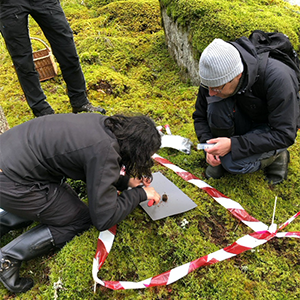Facts:
Participants
- Björn D. Lindahl (PI)
- Anders Dahlberg
- Sara Hallin
- Eveline Krab
- Leticia Pérez Izquierdo
- Johan Stendahl

The aim of this project is to set the foundation for a comprehensive inventory of biodiversity in Swedish forest soils. This foundation could then be implemented at the start of the forthcoming period of the Swedish Forest Soil Inventory, i.e. in 2023 (the current period runs during 2013-2022).
Forest ecosystems represent a valuable natural resource in Sweden, providing not only timber but also supporting a rich diversity of organisms. The Swedish Forest Agency states that the current biological functions of forest soil have to be maintained, but also stresses an urgent need for new biological indicators. In spite of their key role in the boreal forest biome, systematic monitoring of soil biota is currently lacking.

This project is a collaboration between the Swedish Environmental Protection Agency and SLU, as a part of a research program on DNA-based methods in environmental assessment.
Fungal communities in boreal forest soils are particularly species rich, but are currently under alteration (e.g. induced by forestry), with many species declining and red-listed. Environmental DNA related-techniques provide a good representation of the more abundant fungal species that are functionally important for soil processes. Little is known about the distribution and functional importance of bacteria and archaea in boreal forest soils, let alone the anthropogenic impacts on these taxa, and monitoring without DNA based methods is futile.
Soil invertebrate assemblages are reported to be especially sensitive to forest management and other anthropogenic disturbances, and are regularly used as ‘bioindicators’. Although there are well-established methods for assessment of soil faunal communities, morphological identification is time consuming and not possible in a high-throughput context, whereas environmental DNA may offer cost-efficient ways forward.
Swedish forests are in focus as a globally important carbon sink, but different societal actors advocate highly divergent management strategies to optimize carbon sequestration. Much effort is currently invested in environmental monitoring of above- and below-ground carbon stocks in Swedish forests.
The Swedish National Forest Inventory and the Swedish Forest Soil Inventory provide data on annual changes in different forest carbon pools, e.g. for reporting to the climate convention. However, the dynamics of these vast stocks are slow, and changes over time are very difficult to detect, although having a major impact on carbon fluxes. Only by understanding variation and controls of the soil biota, policy and management may be adapted to ensure a sustainable carbon sink in Swedish forests and establish trade-offs between short-term uptake in trees and long-term storage in soils.
Following a hierarchical nested sampling design, 38 (x2) soil cores were taken from twelve plots at different distances. One set of 38 cores was pooled for comparison and for testing the storage effect. Cores to extract soil fauna using conventional methods were also collected and for comparison, sampling was also carried out according to the current tentative inventory of fungal DNA within the Forest Soil Inventory.
Three poor-young forest, three rich-young forest, three poor-old forest and three rich-old forest were sampled. The poor and rich forests are respectively represented by the dominance of Pinus sylvestris and Picea abies. The age of the young forest range from 15 to 20 years old and the old forests are more than 80 years old.
|
|
Professor Björn Lindahl |